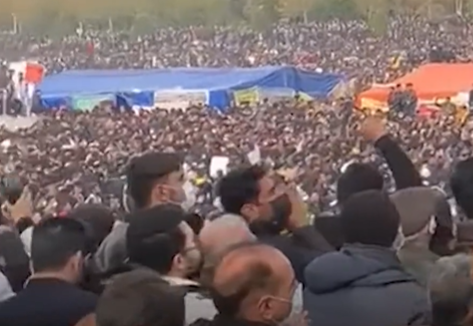November 19, 2021

The crowd is standing in the riverbed as it stretches out from the Khaju Bridge at the far right while the heads in the foreground are of people on the riverbank.
An immense sea of many tens of thousands of Esfahanis has gathered in the city’s dried-up riverbed to protest mismanagement of water resources.
Farmers and their supporters carried signs reading, “Where is my Zayandeh River?” as they packed the cracked ground where the river once flowed, next to the 370-year-old Khaju bridge.
The river, the largest in Iran’s central plateau, has largely disappeared for the past two decades. Part of the cause is drought. But the main cause is the diversion of water to industry and other provinces, chiefly Yazd. There is a normal flow only for several weeks a year when the government opens an upstream dam. Residents then gather en masse to celebrate the river.
The protests began early in November but swelled to massive proportions on Friday, November 19, as people from all across the province joined in what was certainly one of the largest protests seen since the revolution anywhere in the country.
State television, under new leadership, broadcast film of the protest. Announcers emphasized that it was not a “political” protest but focused on water supplies. However, a video posted on social media showed the crowd boing loud and long when a rally speaker wished the Supreme Leader good health.
Chants that were not broadcast on state TV included, “Plundered for 20 years” and calls to get rid of the staff that manages the water flow and diverts it from the river.
One banner being held up said, “Our water is being held hostage.” Many chanted, “Flowing Zayandeh River is our indisputable right” a clear play on the regime-sponsored chant at government rallies of “Nuclear energy is our indisputable right.”
Protests, mainly by farmers, have been going on sporadically since at least 2012. What has changed now is that the non-farming people of the city and adjoining areas have joined in the protest. For the city’s residents, the river is part of the city’s identity. Many have been surprised that it has taken so long for city residents to join the protests.
Two weeks before the mass protest, farmers pitched tents in the dry riverbed. Farmers from the east of the province camped in red tents; those from west side stayed in blue tents.
The livelihood of farmers in the province has been “severely affected” by lack of water in the river, state media reported. The farmers complained that the government has not responded to their needs. Many of the area’s farms grow wheat, and the lack of water has contributed to the decline in wheat production this year.
A major concern is the diversion of water for industry. The regime years ago built a large steel mill at Esfahan. Steel mills suck up immense qualities of water. Many development specialists say a plant like a steel mill should be on the Persian Gulf coast and not in a region that does not have a large supply of water.
During the protest, First Vice President Mohammad Mokhber instructed the Ministries of Energy and Agriculture to take immediate steps to deal with the issue in Esfahan and the adjoining provinces of Yazd and Chaharmahal va Bakh-tiari, state TV reported.
With a population of two million, Esfahan is Iran’s third most populous city.
President Raisi met with environmental activists in Tehran the day of the big demonstration in Esfahan, telling them that the most frequent demand he hears from the people is for water and that water management must be prioritized.
Iran sought to be agriculturally self-sufficient after the 1979 revolution, but intensive agriculture, coupled with years of drought, has heavily depleted aquifers. This has prompted land subsidence, which is now being noticed in the city. Photos posted on social media have shown cracks and depressions around Esfahan’s historic buildings and also around the airport.


















